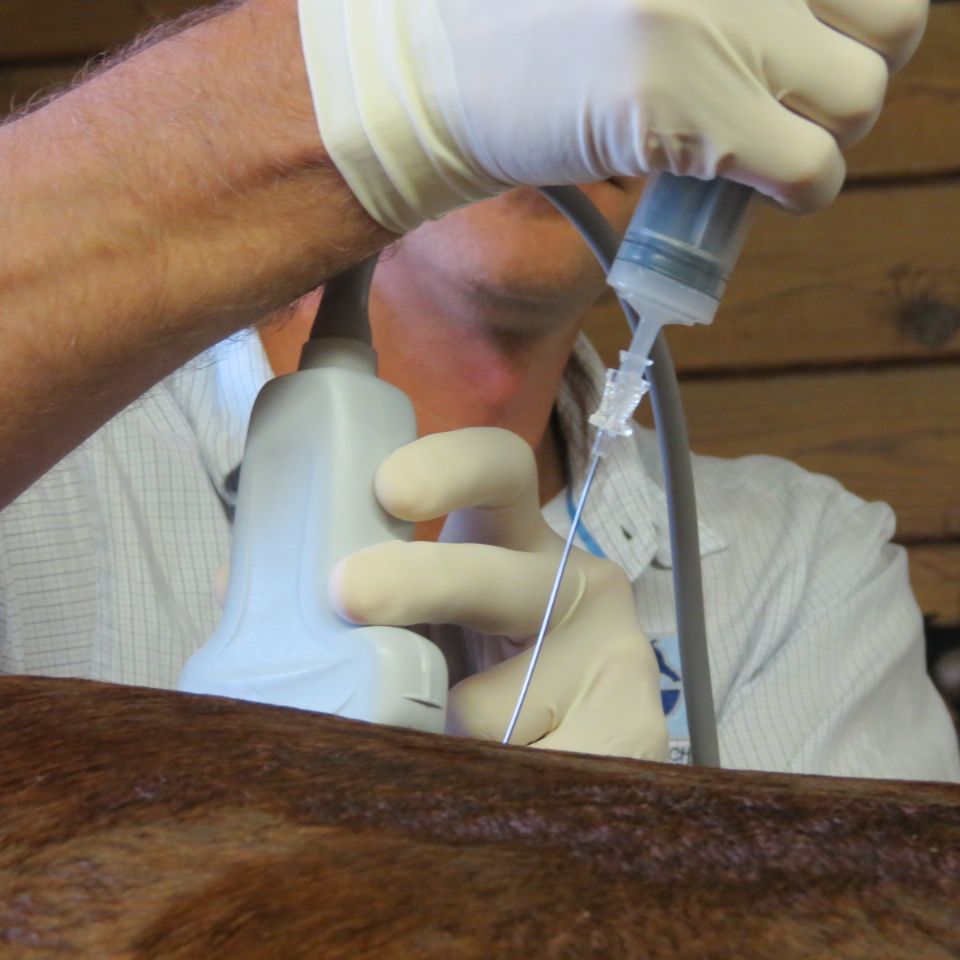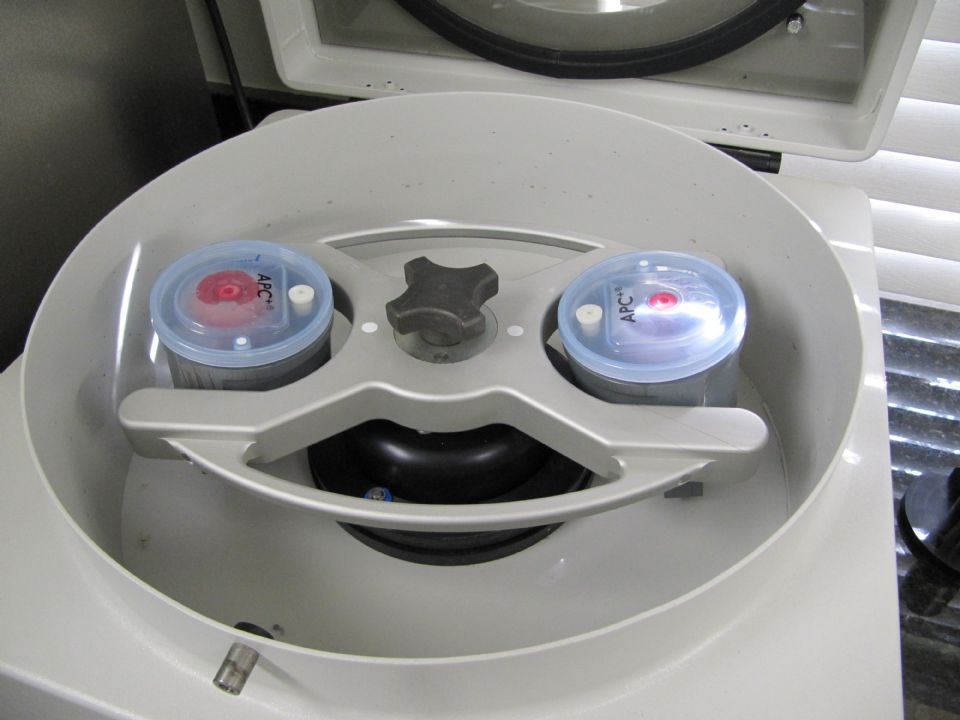Regenerative Medicine Steps into the Future at Palm Beach Equine Clinic
March 20, 2018 - Wellington, FL
Photo courtesy of PBEC
Photo courtesy of PBEC
Photo courtesy of PBEC
As sport horses become faster and stronger, veterinary medicine is often challenged to break barriers to provide the best in diagnostic and maintenance care. Palm Beach Equine Clinic (PBEC), based in Wellington, FL, is consistently on the forefront of those advances, and employs a team of veterinarians equipped with the latest developments in regenerative medicine.
Two resources that have become increasingly popular to treat equine injuries are Platelet Rich Plasma (PRP) and Interleukin-1 Receptor Antagonist Protein (IRAP) to encourage regeneration of injured or degenerative tissue. Managing joint diseases and injuries using these methods is ground-breaking, but logical at their core. They essentially use naturally-occurring proteins, cells, and other natural processes originated from within the body of the horse to put the horse’s own biological mechanisms to work stimulating healing without the use of steroids or other drugs.
What is PRP?
Platelets are among the very first cells to accumulate at an injured site, making them very important when simulating the repair process. Platelets contain granules filled with growth factors (the elements that aid in healing) and stimulate specified tissue to heal at an increased rate. To treat a horse with PRP, the veterinarians at PBEC are able to take a sample of the horse’s blood and concentrate the platelets in a high-speed centrifuge onsite. The harvest and processing procedure takes approximately 30 minutes before the concentrated platelet rich sample is injected back into the horse at the specific area of injury using sterile techniques and guided by ultrasound.
PBEC’s Board-Certified Staff Surgeon, Dr. Weston Davis, explained PRP use in more detail: “We harvest a large quantity of blood, anywhere from 60 to180 milliliters, and we process that to concentrate the segment that is very rich in platelets. We get a high concentration of platelets - we are hoping for five to eight times the concentration that you would get from normal blood. Then we take that platelet-rich extract and inject it back into an injured area to encourage a more robust healing response. Whenever you have an injury, platelets are one of the first cells that get there. They will aggregate, clump, and de-granulate. They release these granules, which are very rich in growth factors, and signal the body to start the healing process.”
What is IRAP?
IRAP is used to treat equine athletes that are susceptible to musculoskeletal injuries and osteoarthritis or degenerative joint disease. Joint trauma results in the release of inflammatory mediators such as Interleukin-1 (IL-1). IRAP uses a horse’s own anti-inflammatory protein found within the blood to counteract the destructive effects of IL-1 to slow the process of osteoarthritis. The process works by binding to the IL-1 receptors in the joint and blocking the continuation of damage and inflammation.
“We often see joint damage in sport horses because of the nature of their work, but we try to avoid overuse of steroids in joints because steroids can have long term effects on cartilage,” said PBEC veterinarian Dr. Samantha Miles. “This is a way we can manage joint disease and stop inflammation without having to consistently use steroids every time. Some of our clients will maintain their horses on IRAP alone for joint injections.”
Introducing MediVet ACS
Dr. Bryan Dubynsky has been specializing in sport horse medicine at PBEC for 12 years and has added another option beyond PRP and IRAP to the clinic’s arsenal of treatments. MediVet Autologous Conditioned Serum (ACS) was developed by Medivet Equine, a leading manufacturer of preventative and regenerative equine therapies. It serves to block and terminate the inflammatory response that leads to tissue destruction, pain, and interruptions from training, competition, or a comfortable life.
Where IRAP makes use of IL-1ra, MediVet’s ACS utilizes both IL-1ra, IL-4,IL-10, IL-13 and it inhibits six pro-inflammatory cytokines and upregulates specific growth factors to stimulate regeneration and expedite healing.
“It’s the IRAP 2.0 if you will,” said Dr. Dubynsky, who started using MediVet ACS two years ago. “MediVet has found a way to get more interleukins involved. We have known there are a lot of interleukins working other than IL-1, but now we have proteins from more interleukins and are blocking more of the inflammatory mediators. It also gives us more volume. I will collect 400-500 milliliters of blood and 40-50 four-milliliter syringes come back to me ready to inject.”
The MediVet ACS collection kit contains everything needed to collect blood and ship it to the MediVet lab where the blood is processed and shipped back, all in less than 72 hours. The process includes the spinning out of unnecessary parts of the blood, patented, specially coated glass beads and the use of patented LED photobiostimulation technology (low-level light) to generate the ACS. Before the product leaves the lab, MediVet filters, checks for bacteria, and doses the finished ACS – when the ACS reaches the horse it is aseptic and ready to inject.
Dr. Dubynsky added, “Another benefit to these regenerative therapies is that you have a total dose limit of corticosteroid you can put in a joint. With MediVet ACS, you don’t. You can put it in as many joints as you want. You start to see improvement in 48 hours and I have seen the level of that improvement significantly higher with ACS over traditional IRAP.”
The goal to better serve sport horses that continue to improve athletically is the driving force behind the development of an even more developed and precise techniques used in regenerative medicine. And, at PBEC, the work to break new ground is never finished.
“I believe we are learning more about these technologies with more advanced science behind what they do and how they do it,” said Miles. “These treatments are natural, drug free, and competition safe, and necessity drives the need for regenerative therapies in the sport horse world.”
Have further questions about the regenerative therapy programs available at PBEC? Visit www.equineclinic.com, or call the clinic today at 561-793-1599 to learn more.





